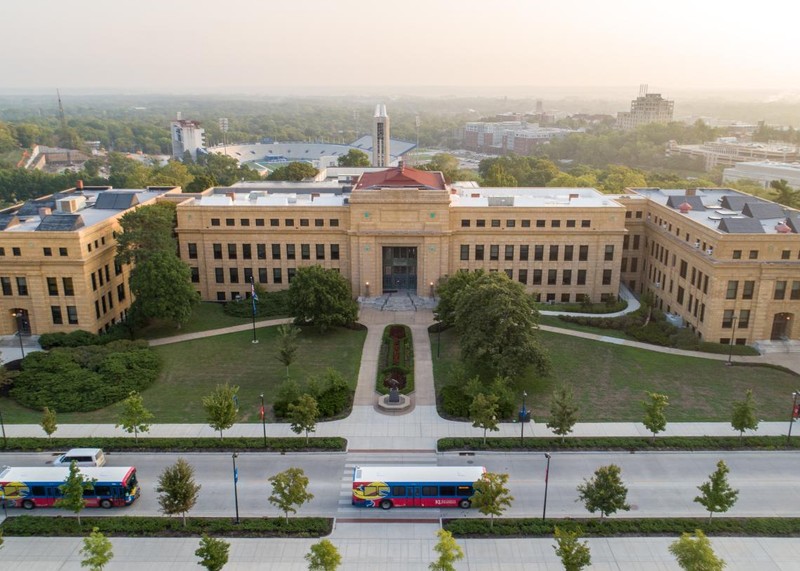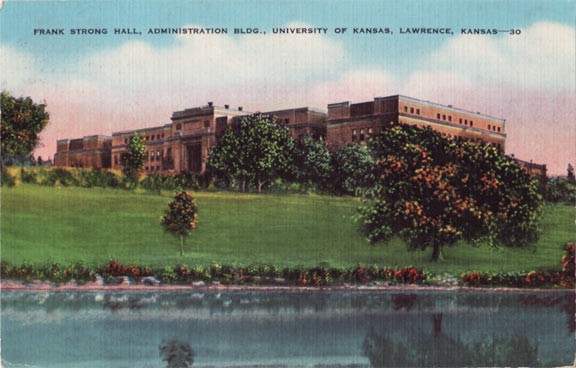Strong Hall, University of Kansas
Introduction
Text-to-speech Audio
Constructed in three phases over twelve years between 1911 and 1923, Strong Hall is a campus landmark and the main administration building at the University of Kansas. The building is named in honor of Frank Strong, who served as chancellor from 1902 to 1920. Strong was a proponent of the new building which would ease overcrowding at Fraser Hall, but the state legislature did not approve enough funding to complete Strong Hall in one phase. As a result, the east wing was completed in 1911, the west wing in 1918, and the center in 1923, three years after Strong's death. When the United States entered World War I, cadets trained at the construction site for the west wing, using the trenches created by construction crews to prepare for conditions they would face in Europe. Strong Hall has been on the National Register for Historic Places since 1988.
Images
Strong Hall

Strong Hall Postcard

Backstory and Context
Text-to-speech Audio
Strong Hall was imagined as part of KU’s first campus master plan. In 1904 the Board of Regents commissioned Kansas City architect George E. Kessler to create “a comprehensive plan for the University’s physical development.” Kessler proposed a beautiful Mount Oread with a massive administration building at the center of its groves and pathways. To design this central administrative building, the University hired St Louis architecture firm Montrose Pallen McArdle. McArdle envisioned the building, which developed into Strong Hall, done in the classical-renaissance style, featuring pillars on the facade, and a huge dome over the center rotunda. Two two-story sections would connect the central feature with its sides, each section containing an art gallery and classical museum respectively. The wings of the building would be three stories each and be designed for classrooms. The projected cost was over $500,000, to which the 1909 state legislature gave $125,000 for the building’s east wing.
The $125,000 allotted for the structure’s east wing was too little for the ambitious plans, forcing McArdle and the University to scale back the project. The 1911 state legislature allotted $42,500 for the central section’s foundation, and work would be delayed by the outbreak of World War I. Work on the building wouldn’t resume for another six years, until the 1917 legislature funded the construction of the west wing, and the 1921 legislature gave $250,000 to complete the central portion and therefore the building. The final structure was devoid of the flair McArdle’s original plan contained. Strong Hall,
…lacked everything that gave proportion and beauty to the original plan: the dome, the pillars, the impressive northern facade, the harmonious connecting sections between the main part and the wings; and while the original plan called for stone facing, the actual facing was an unappealing terra cotta.
University administrators moved from Fraser Hall into Strong Hall during the Christmas break of 1923, construction on the building totally finished in January of 1924.
Strong Hall was thus completed, but it wouldn’t be known by that name for many years. Prior to its 1934 renaming for Chancellor Strong, the structure was known as the administrative building, or more commonly, the “ad” building. As Strong was being constructed in stages, each part took on its own title from the “west ad” to the “central ad.” In 1988 Strong Hall was added to the National Register for Historic Places.
Sources
"Strong Hall", Historic Mount Oread, http://www.jayhawks.com/hmof/landmarks/strong.shtml
“Strong Hall.” KU Directory of Places, https://places.ku.edu/buildings/strong-hall
Griffin, Clifford S. 1974. The University of Kansas; a History. N.p.: University Press of Kansas. P. 240-1
KU's Directory of Places
Historic Mount Oread
